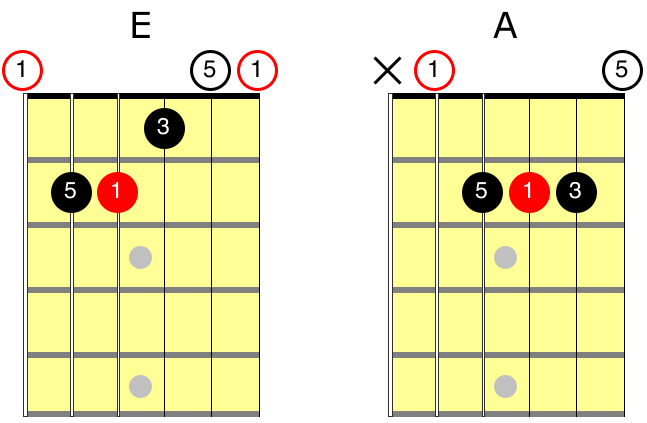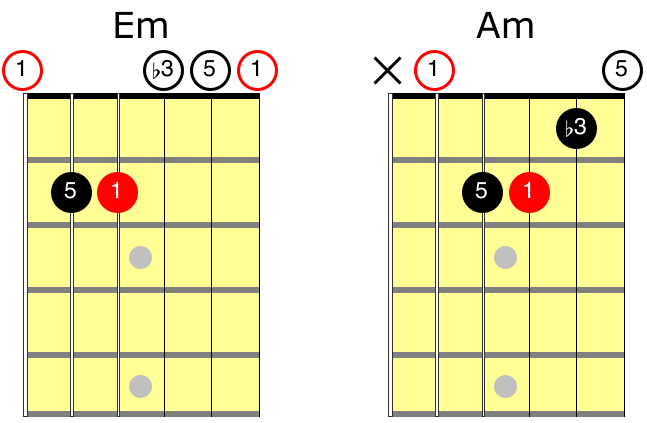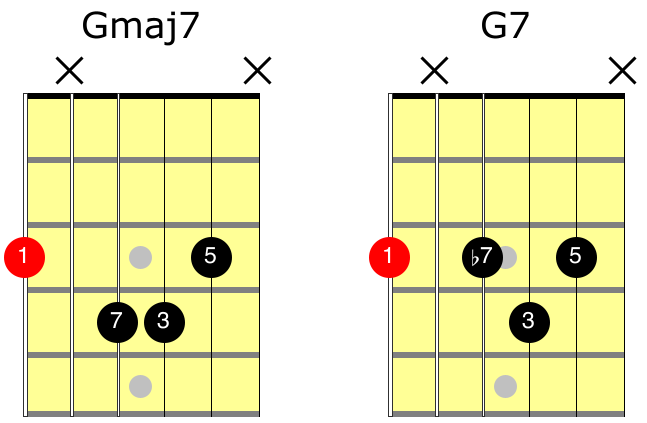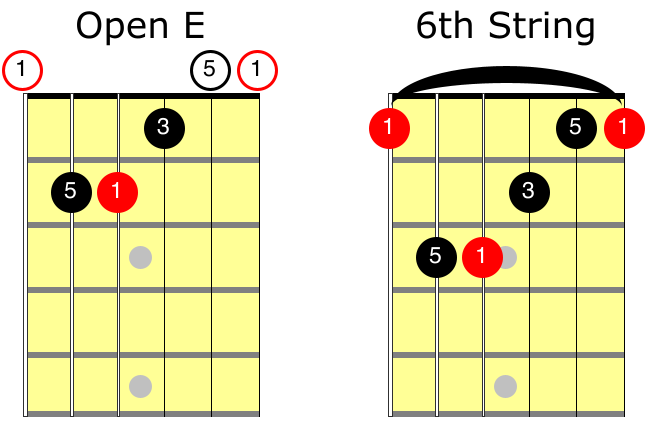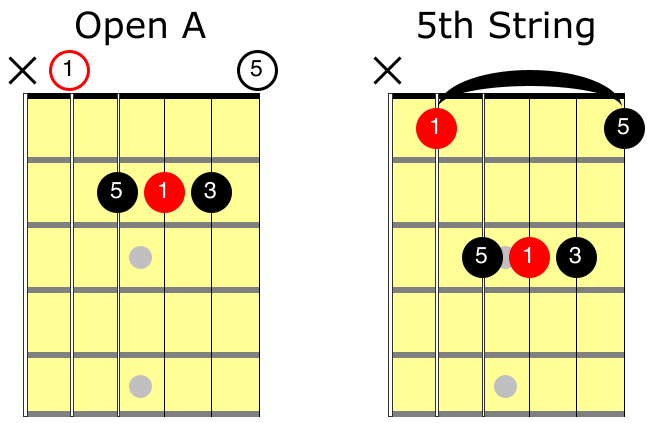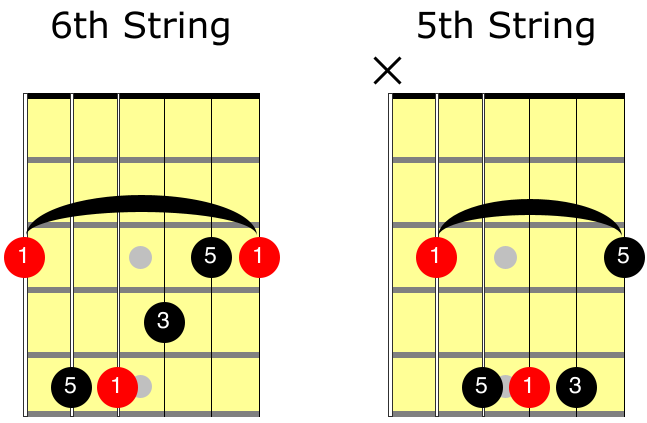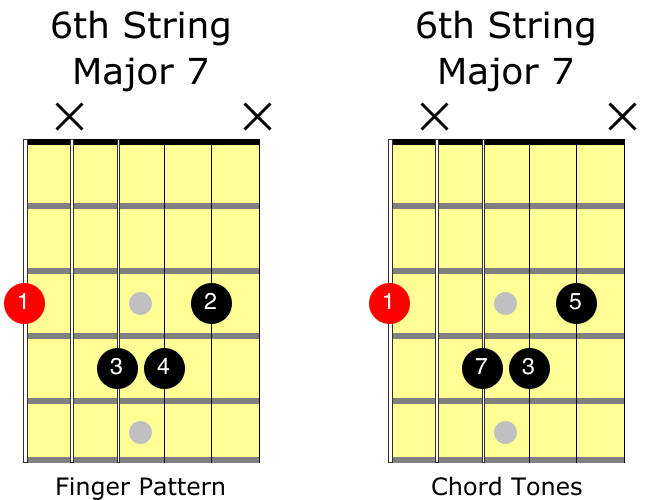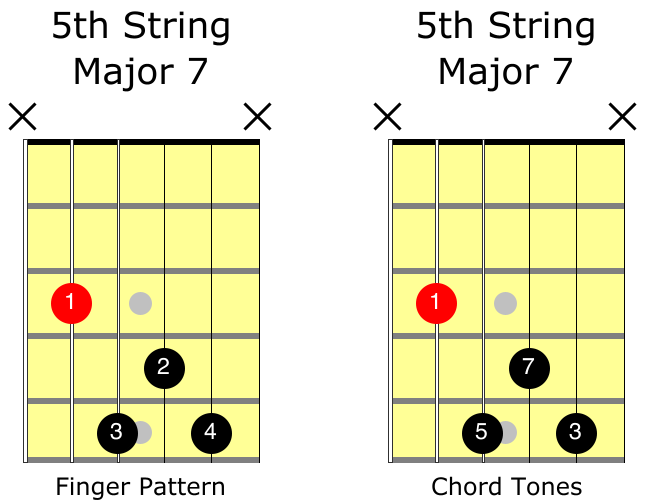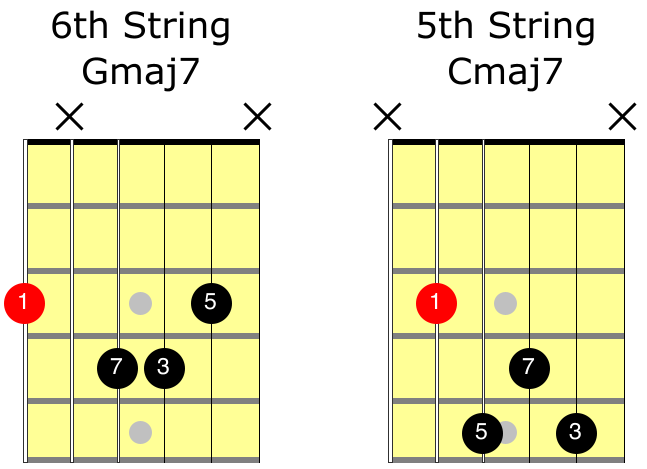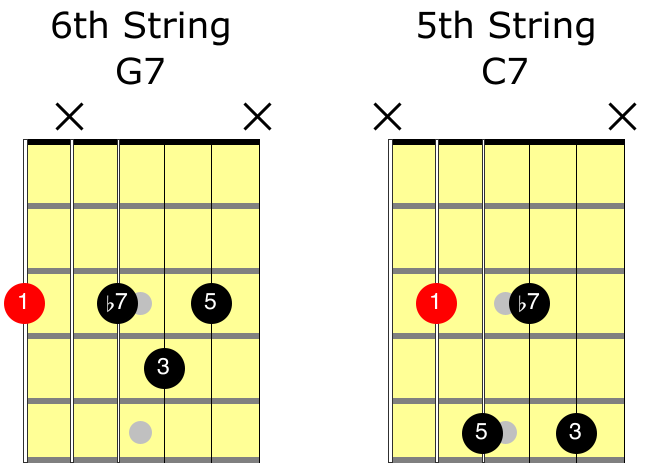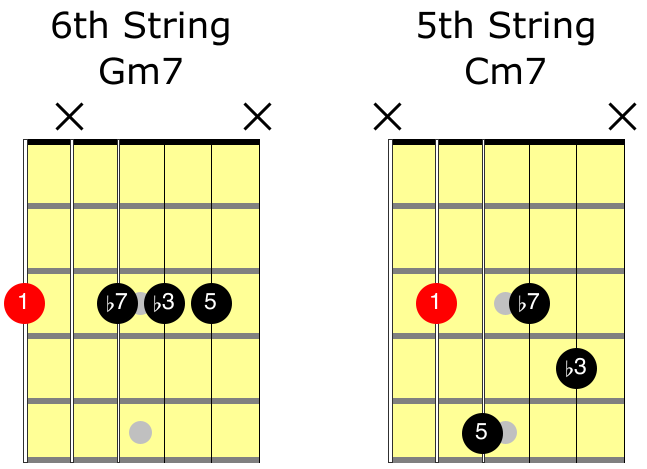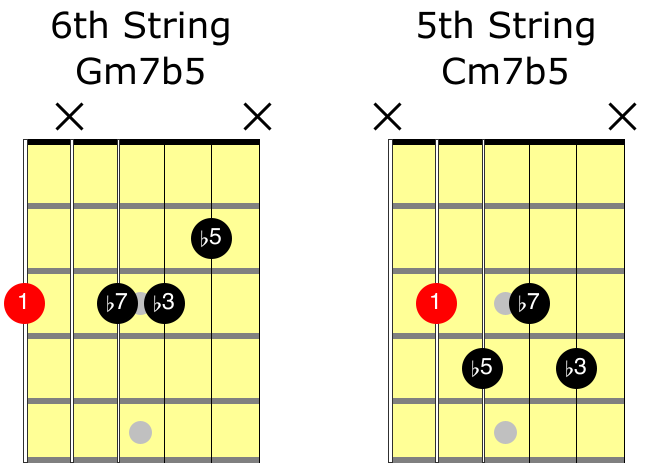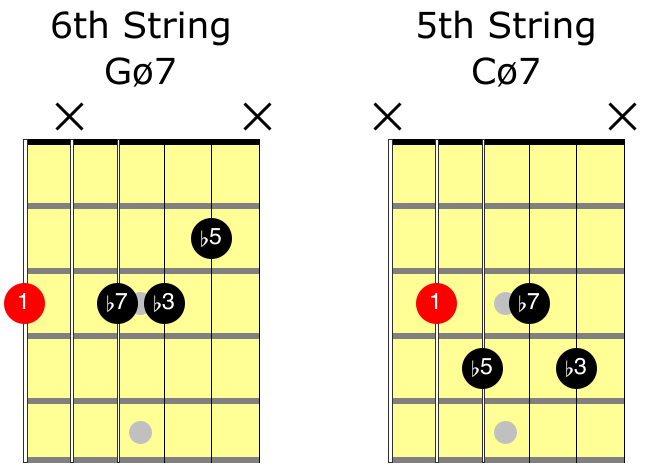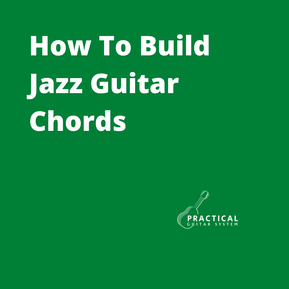 Jazz guitar chords can seem complicated even if you've been playing guitar for a long time in other styles, right? If you look up jazz guitar chords, you're gonna see all kinds of different shapes and it's gonna seem like you have to do tons and tons of work before you can even play anything close to an actual song. Luckily, that's not really the case. In this lesson we're going to look at how to build jazz guitar chords using some common chord shapes you probably already know. You don't need to know a bunch of complicated music theory to do this. You just need to follow a couple of guidelines that I'll share with you throughout this lesson, and put the fingers in the right spots. If you start adapting these kinds of shapes using what I show you here, you'll be on your way to creating your own jazz guitar chords. You'll find that you don't need to reinvent the wheel when it comes to learning jazz guitar, and you don't have to memorize 1000s of chord shapes or buy a jazz guitar chord dictionary. In this lesson, we're going to take a look at how common chords are made. So we’ll be taking a look at a couple of your basic open chords and the corresponding barre chords. And then we're going to look at how jazz guitar chords are made, and how to convert the barre chords you already know into some usable jazz guitar chords. Let's get started. How Are Chords Made?So the normal open chords that you've played since day one playing guitar are technically structures called triads. This means that they're chords that are made up of three notes. It doesn't matter how many strings you actually play, sometimes you're playing up to all six strings. There are still only three unique notes happening. They will repeat at a higher or lower sound, but the note name is the same. This goes for all of your major chords like C, G, E, G, and A. It goes for all your minor chords. E minor, A minor, it doesn't matter what open chord you’re talking about. They're all made up of three notes. So these notes have letter names, and they also get numbers called chord tones or intervals. For our purposes today I'm going to be calling them chord tones. Chord tones are nice because the numbers stay the same no matter what key you are in. As long as you make the finger shape right and get your hand to the correct fret, you’ve got the right chord - it doesn’t matter if you know the letter names of each note or not. (If you want to get good, you need to know the note names too - this is to help you get started without having to think too hard at first) Your major chords are made up of a root (1), a major third (3) and a fifth (5). Your minor chords are made up of a root (1), a minor or flat third (b3) in a fifth (5). Jazz Guitar ChordsJazz Guitar Chords are made up of four notes instead of three. For jazz guitar chords, we’ll start with the 1, 3, and 5 from the basic open chords, but we’ll add a major seventh (7) interval as well. A major seven interval just looks like a seven (7) and a minor seven interval looks like a flat seven (b7). We’ll look at the chord symbols later in this lesson. When we start building chords for jazz guitar, we don't usually have repeating notes. Having more than one of the same chord tone is something we generally try to avoid. That's why if you're looking at a resource for jazz guitar chords, you're not seeing a lot of big chord shapes that take up five or six strings. Most of the time you're seeing chords that use three or four notes and have a couple of strings muted. The key to knowing how to build your own jazz guitar chords is to understand what's going on in the open chords or barre chords that you already know. Once you understand how the chords you're already familiar with are built, you can start to modify them to create real jazz guitar chords that sound good. What Your Major Chords Are Made OfLet's take a look at two normal open chord shapes that are going to be easy for you to change into jazz guitar chords. In this lesson we're going to look at an open E chord and an open A chord. Both of these are going to be turned into barre chords or moveable chords, and then later we'll convert them into movable jazz guitar chords. Open E ChordThis is a common open chord shape that can be also used as a movable or barre chord. And this is one that a lot of people know if you've been playing guitar for very long and moved beyond your open chord shapes. This chord can be thought of as a chord with a root on the sixth string for our purposes today. Open A ChordThis is another common open chord shape that is usually also used as a moveable or barre chord. This chord shape for our purposes today is going to be thought of as a chord with its root on the fifth string. Both of these chords (6th string and 5th string) are very common, and you’ve probably learned them before (That’s why we’re using them as a jumping-off point). You may have different ways of thinking about them, different ways of labeling them depending on who you've learned from. That’s ok - lots of teachers have different methods for communicating the same material. But for us right now we're going to think of it as a six string root and as a fifth string root. The make up of both of these chords are just three notes. We've got a root, a third and a fifth. So for both of these chords if you take a look at the graphics above, you have some repeating notes. Sometimes you have more than one five, more than one three, more than one root. In order to make these into jazz guitar chords. What we need to do is get rid of some notes and change one interval. Converting To Jazz Guitar ChordsWhen we're looking at our common bar chords and our common open chords for guitar playing, it's okay to double notes. It's part of what we do as guitar players all the time; it makes for a bigger sound and helps add to the volume of what we're playing. And it's pretty common in a lot of styles that are based in popular music, rock, blues, country - for any kind of pop music this is a very common thing to do. For jazz guitar chords however, we ideally want just one of each chord tone that makes up the chord. This is going to give you more control over the chord, so that if you change one note you can change what kind of chord you are playing. This is an important detail that later on is going to help you build your chord vocabulary without having to do a ton of chord shape memorization. 6th String ChordWe only need one root, so we're going to keep the one that's located on the sixth string. We're going to get rid of the root that is on the fifth string. This avoids creating a power chord type sound. For the root on the fourth string, let’s lower that one fret so now it's a major seventh chord tone. Keep the third that’s on the third string, we're going to leave that where it is. And then keep the fifth that's located on the second string. Get rid of the Root on the first string, and you've got a classic major seventh chord with the root on the sixth string. Playing TipsStart by using the suggested finger pattern and avoid the temptation to barre this at least for now. We want to use one finger per note as much as possible, because it’s going to give you more control over the chord and help improve your technique. 5th String ChordAgain, with this chord we only need one root. So keep the root on the fifth string this time. We're also going to keep the fifth that's on the fourth string. For the root on the third string, we're going to lower it one fret so it becomes a major seventh chord tone. And then we're going to keep the third that's located on the second string, and get rid of the fifth that's living on the first string here. Now you've got a classic major seventh chord located on the fifth string. Playing TipsStart with the suggested finger pattern. And again, avoid the temptation to barre this chord shape. For most of these chords, our ideal is going to be to have one finger per note. Sometimes it just makes sense to barre different chord types, but there is no need for these major 7th chords. You can do this with one finger per note. These Are The BasicsPractice converting these two moveable chord shapes into jazz guitar chords until it's easy for you to do. Get used to recognizing them as a 6th string and a 5th string chord shape. From there you have some options. You can convert other barre chords you already know into jazz guitar chords using the principles we used the above for these two shapes. If you know barre chord shapes for minor chords, seventh or minor seventh chords, you're already on your way. It's just a matter of eliminating extra chord tones. And making sure you have just one of each chord tone that makes up the cord, one root, one third (3), one fifth (5), and one seventh (7). Another option is to use the two major seventh chords from above to generate the other common jazz guitar chords - dominant seventh minor seventh and minor seven flat fifth. By changing one chord tone at a time, you can create all of the different jazz guitar chords you might need. This is the approach we’re going to take for this lesson. See the section below for examples of how to do this and to practice. With a little work, you can use these two jazz guitar chord shapes to start developing your vocabulary without having to learn 1000s of jazz guitar chord shapes. Basic Jazz Guitar ChordsThese two shapes can help you generate a variety of different jazz guitar chord sounds. There are four primary chord types you need to get used to: Major seventh (maj7) which we've already covered as a root (1), third (3), fifth (5), and seventh (7). Dominant seventh chords (7) have a root (1), third (3), fifth (5), and flat seventh (b7). Minor seventh (min7) chords include root (1), flat third (b3), fifth (5), and flat seventh (b7). Minor seven flat five (min7b5) chord includes the root (1) flat third (b3), flat fifth (b5), and a flat seventh (b7). Note: the minor seven flat five chord can also be called a half diminished (ø7) chord depending on who wrote the chord symbol you're looking at. Moving ForwardYou don't need to reinvent the wheel to learn jazz guitar. If you know some common barre chords or movable chord shapes, you've already seen how easy it can be to adapt them and create your own jazz guitar chords. It's simply a matter of getting rid of extra notes and making sure you have just the essential chord tones. While there's definitely more to it if you want to get really good, this is enough to get you started and get you playing. With practice, you'll be able to build up your jazz guitar vocabulary using chord shapes you already know basic theory and the principles you've learned in this lesson. Once you're comfortable getting your fingers onto these cords, try putting them to work in your playing. Related PostsCheck out the lessons below to learn more: Step By Step Guide To ChordsIf you're looking for a step by step guide to building jazz guitar chords, check out our course - Jazz Guitar Survival Guide: Chords and Comping.
This course will give you everything you need to know to start building your own jazz guitar chords and exercises to help you put them into practice. Click here to check it out.
0 Comments
Leave a Reply. |
Archives
October 2022
Categories |

